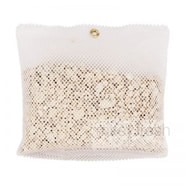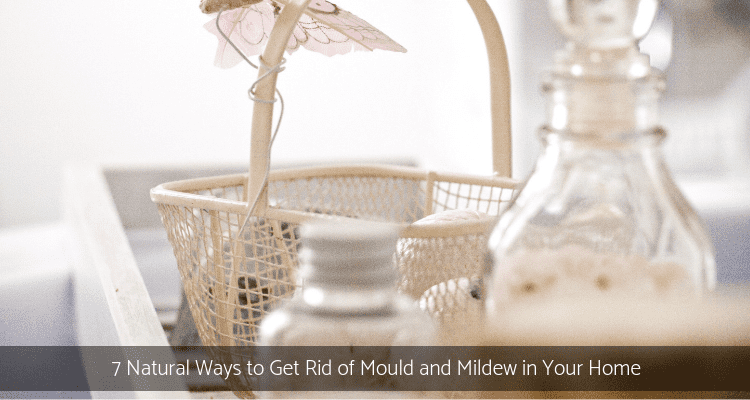Rising levels of dampness in your home during the summer and rainy season can spur growth of mildew and mould. The basement, attic, garage, cupboards, and bathrooms are particularly susceptible to developing fungi.
Not only does the site of the fungi growing in your home present a major ‘yuck’ factor, mould and mildew growth is bad for your health. Overtime the mildew and mould on walls can cause structural damage and eventually require that you spend huge amounts in home repairs.
Mould and mildew can spread quickly in the house and you must ensure that the affected area is cleaned as soon as possible. However, most commercial cleaning products contain industry strength chemicals that can pollute the air in your home.
Instead of using harsh chemicals, try these 5 natural ways to get rid of the mould and mildew in your home.
1. Vinegar: Vinegar is a natural antimicrobial substance. Effectively kill the mould spores and other bacteria by spraying white vinegar on the affected area using a spray bottle. Let the vinegar sit for a while before wiping clean with a microfibre cloth. If the smell of vinegar bothers you, add a few drops of essential oil. For preventing growth of mould, simply spray the solution and leave it to dry.
2. Tea tree oil: Add two teaspoons of tea tree oil to two cups of water and spray the solution on the mould-affected area. Let the solution sit for a while, before wiping away the mould. Although more expensive than some of the eco-friendly remedies, tea tree oil is a very effective mould remover and will fill your home with a lovely scent.
3. Vodka: Use any cheap brand available at home to clean the mould. Spray the vodka directly on the mould and let it work for a while before wiping it clean with a damp cloth.
4. Hydrogen peroxide: Hydrogen peroxide comprises of water and oxygen. Mix equal portions of hydrogen peroxide and vinegar and pour it into a spray bottle. Prepare only as much hydrogen peroxide solution as you need as light breaks down its potency.
5. Baking soda: Apart from being a natural disinfectant, baking soda is very mild and does not leave a scent. Dissolve baking soda into a water-and-vinegar solution. Spray the solution on the surface, letting it sit, before scrubbing with a damp cloth.
In addition to natural mould-mildew cleaning solutions, we recommend the following chemical-free products to prevent fungal growth.
6.
PRODUCT:
Zeolite- Bag of Rocks
Eliminates moisture, damp and musty smells safely and naturally from any wardrobe or room. Reduce mould, mildew, dampness, condensation, odours.

7. One of the most effective ways to control humidity and mildew growth in your home is to place a dehumidifier in your home. A dehumidifier pulls moisture out of the air and robs fungi of the damp conditions it needs to thrive.
For more information on keeping your home naturally clean, follow us Facebook, Twitter, and Pinterest.
Towards healthier living, Carol Parr ♥
As Building Biologists, we have acquired knowledge of adverse health effects and recommend effective strategies to reduce occupants’ exposure by eliminating and controlling as many sources of pollutants in order to create healthy indoor living environments that are as exposure-free and natural as practically possible.
References:
R., M. (2014). Dealing with mould – and the answer isn’t clove oil – ABC Kimberley WA – Australian Broadcasting Corporation. [online] Abc.net.au. Available at: http://www.abc.net.au/local/audio/2014/02/21/3949837.htm [Accessed 26 Mar. 2019].
World Health Organisation. (2009). WHO Guidelines for Indoor Air Quality, Dampness and Mould. (Online). Available: http://www.euro.who.int/__data/assets/pdf_file/0017/43325/E92645.pdf
National Institute of Medicine. (2004). Damp Indoor Spaces and Health. National Academies Press. (Online). Available: http://www.nap.edu/openbook.php?record_id=11011&page=R8
Author
-
We’re glad you’re here. We’re Carol and Tony, founders of one of the longest running Healthy Home Blogs in the world, Mitey Fresh Australia. We’ve been on this journey for the last 25 years and are passionate about helping families sift through health hazards and triggers like allergens, mould, water damage, chemicals and EMFs, to get clarity about what’s toxic and what’s not so they can create a healthy and happy home for their family they love. Each month, people visit this blog seeking focus on the health and wellbeing of their loved ones, sustainable and effective practice tips and guides, to help create and manage healthier indoor spaces, improve the built environment that is pleasing to the senses and support healthy living and nature, every day. Starting this blog was to help change people’s lives, one family at a time, and we can’t wait to share how its allowed us to stand next to you and show you how interpreting these synergies between buildings and the environment they are built in will impact upon the health and well-being of those who occupy them. Find out more about Healthy Homes and what this blog can do for you!






Pingback: Causes and Symptoms of Mould Allergy
For the peroxide and vinegar spray, do you use 3% peroxide or 6%? Also, what things are safe to use this spray on? I wouldn’t want to accidentally bleach something with the peroxide.
Hi Elisa,
Try the 6% peroxide as it will be slightly stronger.
Be careful not to use on anything metal.
Here are all the household uses: http://www.using-hydrogen-peroxide.com/uses-of-hydrogen-peroxide.html
Carol